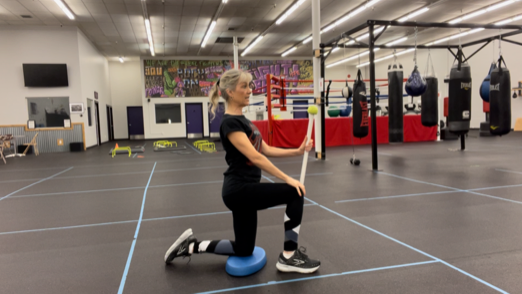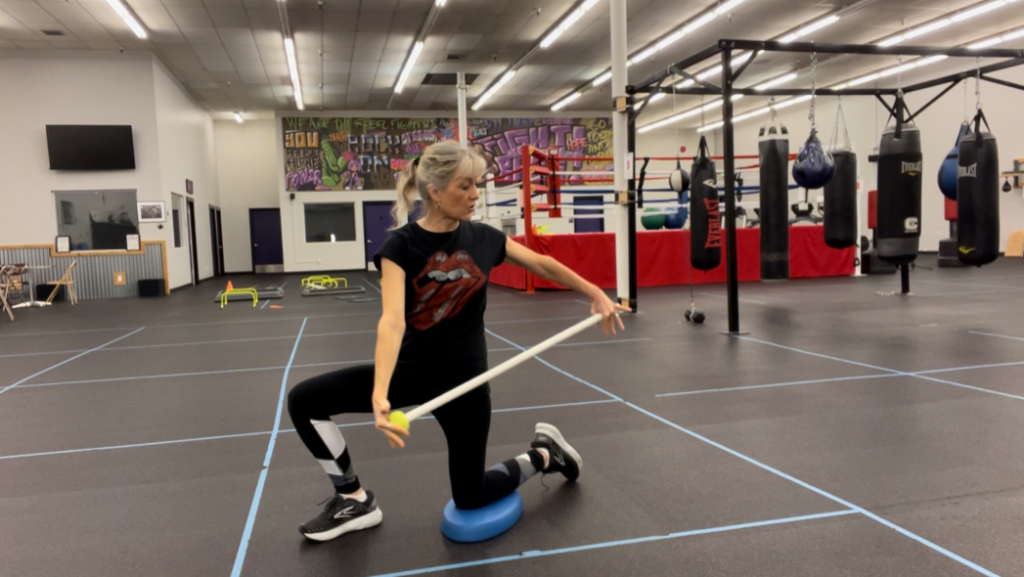
With rotation, sequencing, and balance all being common issues for people with Parkinson’s, I often include the half-kneeling chop to our boxing boot camp classes. This exercise can be somewhat challenging to learn in the beginning, but now many of my fighters can do an even more advanced version using a medicine ball or dumbbell.
The half-kneeling chop offers many benefits because it targets multiple muscles at once, including:
Shoulders: Your rotator cuff and deltoid muscles help you move the weight from high to low. Meanwhile, the scapular stabilizers help keep your shoulder blades stable as you move.
Core muscles: The transverse abdominis and obliques work to stabilize your body as you perform the entire movement. This can help with better stability, balance, and posture.
Hip stabilizers: The gluteus medius, gluteus maximus, and piriformis all help with balance as you move about your day.
The half-kneeling chop is a functional exercise and can increase your range of motion and balance, making everyday activities like lifting or raking much easier. It also helps activate the muscles you need for rotational movement. That makes it a great exercise for people who play golf, tennis or pickleball. Since it stabilizes your core, it may even help relieve lower back pain.
Watch this video to learn how to do the half-kneeling chop:
Here are step-by-step instructions for how to perform the Half-Kneeling Chop:
- Assume a half-kneeling position; kneel on one knee with the other knee bent in front of the pelvis at 90 degrees.

- After positioning the half-kneel, sit up tall with both hands grasping the dowel with a wide grip.

- Exhale, rotate the dowel across your body, and chop toward the kneeling knee. Always chop toward the down leg.

- The rotation should be a crossbody pattern—think about moving diagonally rather than up and down.
- Return to the starting position, making sure you do not flex forward or sit back.
- Repeat by switching the kneeling leg and start over chopping toward the down knee.
- Perform 10 repetitions on each side with good form two to three times per week.
You should start to feel looser and more flexible after a week or so of performing this exercise. Don’t get discouraged or give up because you feel wobbly doing it. It takes practice!

P.S. Our Virtual Posture School is now in session!
Do you want to be a part of our Posture School, but live too far away to come to the Rebel Fit Club? Not a problem—we now have Virtual Posture School!
There are many benefits to taking Posture School virtually:
- Classes are taught in an easy, step-by-step, building block process.
- You get a new workout five days a week for five weeks—that equals 25 workouts!
- You get to do it in your own home, so no need to miss out because you live too far away.
- You can ask a loved one to join you in the workouts.
- Workouts are recorded, so you pick the time of day that’s most convenient for you.
- You can also go back to previous workouts if one feels especially helpful.
** This course is for people who can get up and down from the ground easily and independently. If you are at high risk for falls, ask about our seated version of Posture School.
The introductory price for Virtual Posture School is just $49! Click here to purchase.
Ready to take back your fight?
Contact me to get started in Kimberly Berg’s Rebel Fit Club Parkinson’s Boxing classes today. We have online workouts, too!
Subscribe now to get more tips and exercises for Parkinson’s delivered right to your inbox!